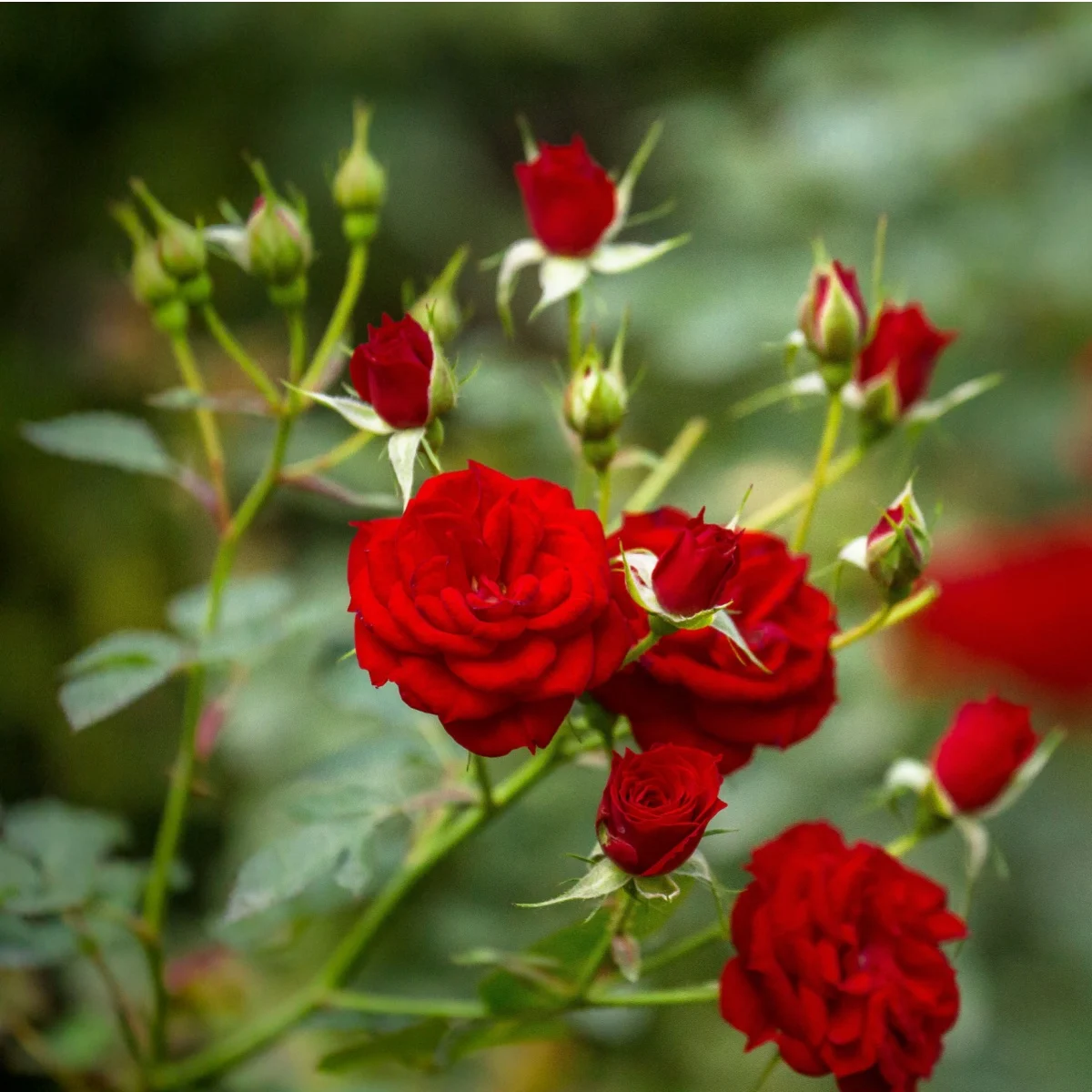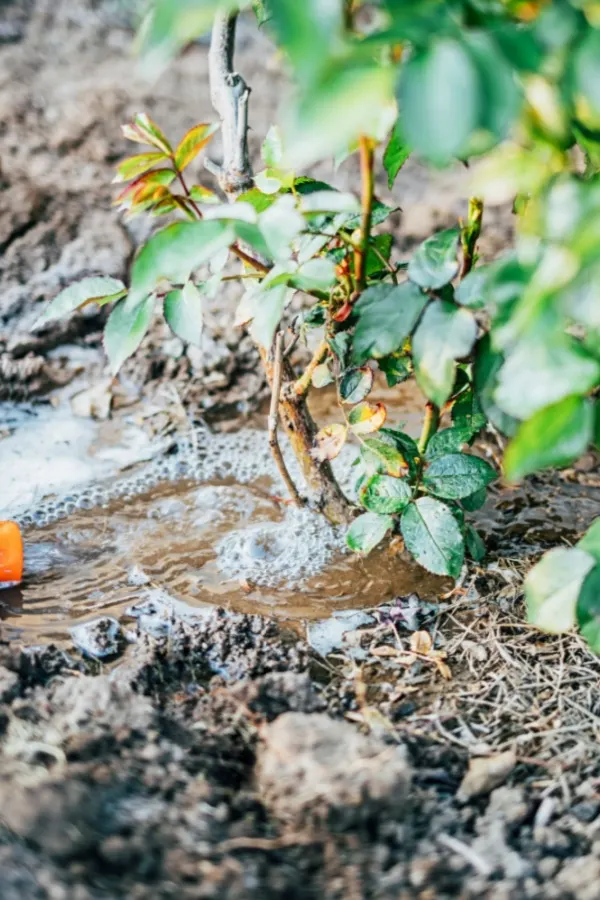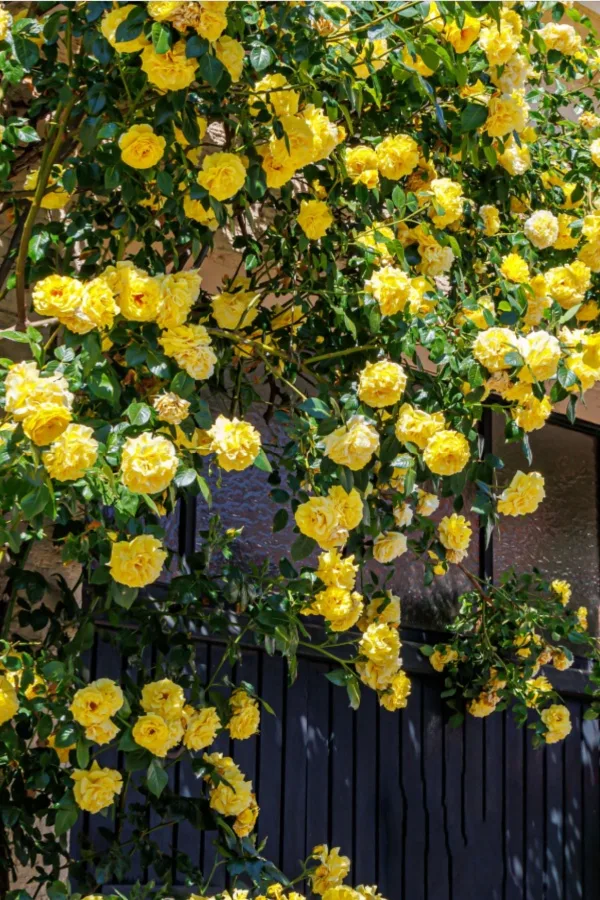One of the best ways to keep your rose bushes healthy and strong and produce a heavy supply of gorgeous flowers throughout the season is to fertilize them at just the right time – and with just the right set of nutrients!
Rose bushes are what are considered to be heavy feeders as plants. This means they require more nutrients from the soil compared to most other perennial plants.
This is due to the fact that rose bushes have a long growing season and produce a large number of blooms. This constant growth and flower production demands a steady supply of soil nutrients to help them along.

Unfortunately, because of that constant need for energy, they can deplete the soil of the nutrients they need most fairly quickly. And without a sufficient supply of energy, they can quickly begin to lose their luster and their potential to flower.
Not only will they produce fewer blooms, the entire plant’s health will suffer. The green foliage can become far less abundant, and the once healthy stems will begin to weaken as well. Even worse, once rose bushes start to suffer, they then become an easy target for disease and pest damage.
So how do you keep your rose bushes looking strong, healthy and blooming? It all starts with applying the best fertilizer at the right time – and using the right method to do so!
How To Fertilize Rose Bushes – The Secret To More Blooms!
Although there are many different varieties of rose bushes, most can be divided into two main categories – climbing roses and shrub and tea rose bushes. When it comes to how often and when they should be fertilized, there are some slight differences among the two groups.
Climbing roses are less aggressive when it comes to absorbing nutrients from the soil. They tend to have a more slow and steady feeding ritual that allows them to produce both their foliage and flowers on a consistent basis.
Therefore, for climbers, it’s best to fertilize them in early spring and once again in late summer before they go dormant for the winter. On the other hand, shrub and tea rose bushes that produce multiple clusters of blooms require constant feeding to develop enough energy to produce all summer long.
Once they spend their power producing their initial group of blooms, they then need more nutrients to power flowering over and over again. As we will cover below, shrub roses need a slow and steady application of fertilizer to keep them lush all season long.
However, not all fertilizers are created equal. So before you go out and purchase your fertilizer, here is a look at which ones work best for roses – and how to apply them.
The Best Fertilizers For Rose Bushes
When it comes to fertilizers for rose bushes, there are two different types – granular fertilizer and liquid fertilizer. Both have their place and can be effective depending on the variety of rose bush that you are growing and the timing of the application.

Granular fertilizers are small, dry and grain-like. They are easy to sprinkle around the plant’s base. Once the ground gets water they begin to slowly release their power into the soil rather than providing them with a big boost of energy all at once.
Liquid fertilizers on the other hand are far faster when it comes to giving nutrients to your rose bushes. Because they are water based, they can soak through the soil quickly and even be absorbed by the foliage.
Finally, no matter what type of rose fertilizer you are using, it’s important to make sure it is geared toward roses. Roses thrive in soil that is just slightly acidic. Therefore, when choosing a fertilizer, it’s important to always select a fertilizer with that in mind. This makes it easier for your plants to absorb energy and keep the soil in that slightly acidic range.
Now let’s take a look at how to fertilize each of the two main types of rose bushes (climbing / shrub & tea) – and when and where to use granular fertilizers and liquid fertilizers
How To Fertilize Climbing Rose Bushes
Climbing roses only need to have one type of fertilizer to power their growth – and that is a granular one. For climbing roses, the first dose of power should be applied in early spring as soon as the first leaves begin to emerge.
For best results, look for a fertilizer that is not only geared toward roses, but also contains calcium. The calcium will assist with strong stem development which will help support the blooms once they emerge. (Product Affiliate link : Espoma Organic Rose-Tone 4-3-2 Organic Fertilizer With Calcium).

Sprinkle the granular material around the base of the bush. It’s best once you apply to rake in the fertilizer a bit into the mulch or soil. This will help to get the grains into the soil to start working. As for how much, it’s always best to follow the recommended dose on the back of your fertilizer package.
The second dose of granular fertilizer for climbing roses should go on in late summer. This will help promote growth in plenty of time before the plant goes dormant for the winter. This all-important second dose is what will help power next year’s blooms.
However, be sure that you don’t fertilize too late in the year. Late fertilizing promotes late growth. And that can be highly susceptible to winter damage.
How To Fertilize Shrub & Tea Rose Bushes
For shrub and tea roses, it’s best to use a combination of granular and liquid fertilizers. The granular application helps give a steady, early supply for healthy growth. The liquid, meanwhile, helps to power and re-power bloom sets all summer.
Start by applying an early spring application of granular fertilizer to help produce strong stem growth and foliage. Again, look for a granular product that has calcium and is good for roses. The Espoma product recommended above for climbers is also perfect for shrub and tea roses.
After that initial granular feeding wait until the first set of blooms appear. Then apply a dose of liquid fertilizer every 3 to 4 weeks throughout the spring and summer. Compost tea, worm casting tea or a liquid rose fertilizer all are great choices. (See our article: How To Fertilize Flowers With Compost Tea – Grow More Blooms – Naturally!).
Although many plants can tolerate having the liquid fertilizer on the actual foliage and blooms, it’s best to water roses at the soil level and not on the actual plant. This is because rose bush leaves are very susceptible to damage. Instead, use the liquid fertilizer around the base of the plant.
Finally, about 6 to eight weeks before the last frost date, fertilize your shrub and tea rose bushes one final time using the granular fertilizer. Now your plants have all the nutrition they need to get them through the winter and into the next growing season.
Here is to fertilizing your rose bushes this year in just the right way at just the right time. And to having their biggest and best blooms ever!
Simple Garden Life
Follow Our Facebook Page For Even More Great Tips! Simple Garden Life Facebook Page
Simple Garden Life is a website dedicated to keeping gardening fun, simple and enjoyable! We publish two new articles each week along with a new garden podcast episode every two weeks. This article may contain affiliate links.


